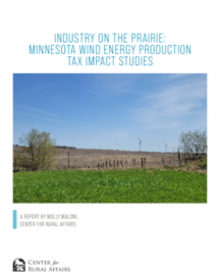A report by Molly Malone, Center for Rural Affairs
The Great Plains is an excellent location for renewable energy resources. The wind that steadily blows an open field of prairie grass also moves the blades of wind turbines. As rural populations decline, tax revenue from wind energy production helps offset lower revenues from the shrinking tax base.
The geography and space of rural areas are often well-suited for wind energy. In 2021, 28 rural counties in Minnesota received $14.1 million in combined revenue from the wind energy production tax. More than 85% ($12 million) of the revenue went to the top eight producing counties—Lincoln, Mower, Nobles, Jackson, Pipestone, Murray, Rock, and Cottonwood—all in southern Minnesota. The median income of communities in this area falls below the state average, so the supplemental revenue is even more critical.
Anyone who has spent time in southwest Minnesota knows it’s almost always windy. The geography of Buffalo Ridge—a 60-mile stretch of rolling hills sitting roughly 1,900 feet above sea level—is the reason. The geographic characteristics of the ridge, in combination with the surrounding flat lands, ensure the wind will not be dying down any time soon.


